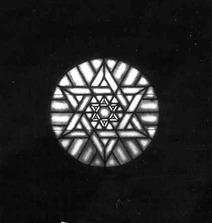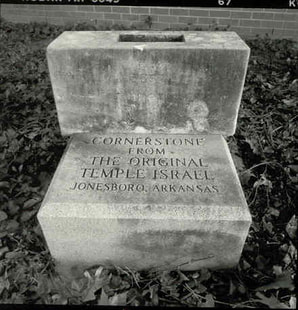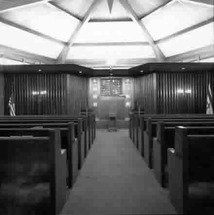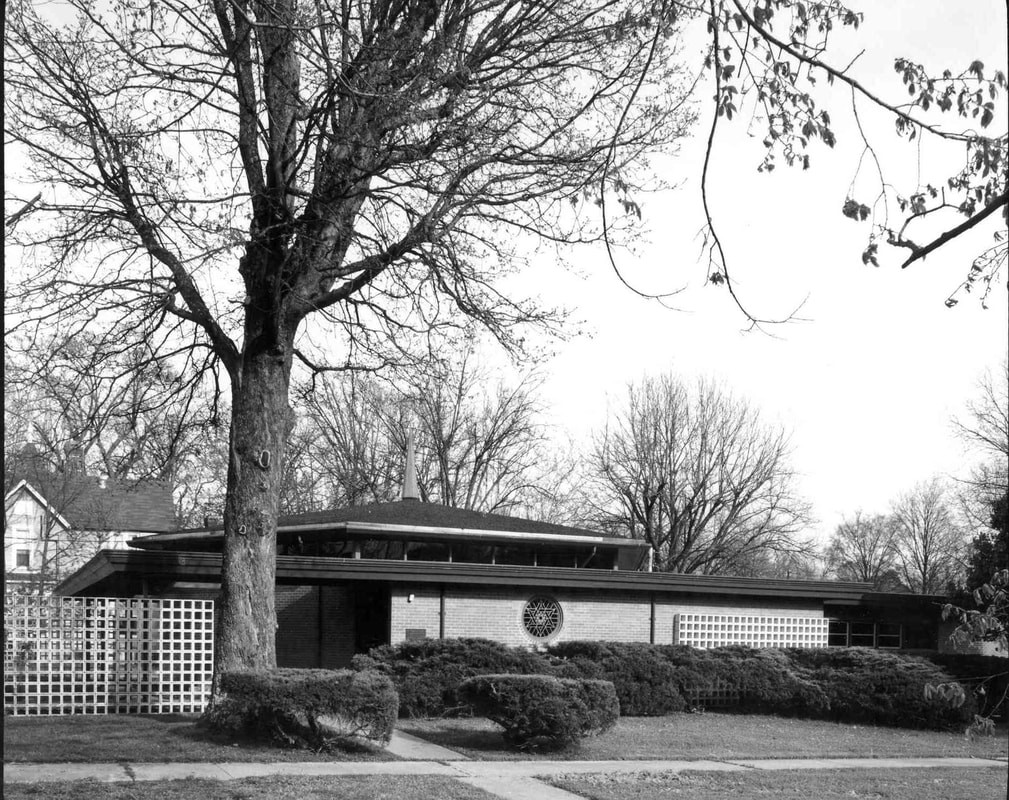Encyclopedia of Southern Jewish Communities - Jonesboro, Arkansas
Overview
Jonesboro sits on Crowley’s Ridge in northeast Arkansas, a location that has historically protected it from the floods that periodically inundate the surrounding lowlands of the Arkansas Delta. The town was officially established in 1859 as the seat of newly formed Craighead County. A railroad arrived in 1883, after which the town became a major trading hub. Jonesboro continued to grow throughout the 20th century, first as a market town, then as a manufacturing center, and more recently as an educational and medical hub.
Jewish settlers began to call Jonesboro home by the early 1880s and developed their own local institutions before the end of the century. The city’s Jewish population fluctuated in the early 20th century but rose with the local manufacturing boom that took place after World War II. Although the Jonesboro Jewish population declined in the late 20th and early 21st centuries, the community continues to support a synagogue as of early 2024.
Jewish settlers began to call Jonesboro home by the early 1880s and developed their own local institutions before the end of the century. The city’s Jewish population fluctuated in the early 20th century but rose with the local manufacturing boom that took place after World War II. Although the Jonesboro Jewish population declined in the late 20th and early 21st centuries, the community continues to support a synagogue as of early 2024.
Early Jewish Settlers

The first known Jews to settle permanently in Jonesboro arrived around the time that the railroad reached town in 1883. Jewish immigrant Rudolph Meyer reportedly arrived in the early 1880s after peddling in the area. He opened a dry goods store that developed into a department store known as the Grand Leader. By 1903 it occupied more than 21,000 square feet of retail space. Rudolph’s brother Max joined him in Jonesboro before 1890 and operated a grocery business and a rice farm.
Other early arrivals included Marcus and Henrietta Berger, who lived in Clay County Arkansas before moving to Jonesboro around 1881. (The 1900 census lists his birthplace as Austria and hers as Germany.) Marcus Berger became recognized as a leading merchant in Jonesboro, and the family was widely known in and beyond Arkansas. Their son Joseph married Essie Blass, daughter of Gus Blass of Little Rock. When Marcus died in 1906, newspapers in Little Rock, St. Louis, and other cities noted his passing.
Jewish migrants also found their way to more rural areas near Jonesboro. Nathan Blecker, originally from Bauska (in present-day Latvia), settled east of Jonesboro near the St. Francis river around 1890 and opened a dry goods store. His wife, Mollie, and their children did not immigrate until the early 1900s, however. The rest of the family settled in Memphis eventually and participated in the larger city’s Orthodox community. Blecker reportedly spent weekdays in Arkansas managing his business and traveled to Memphis on weekends to spend time with his family.
Other early arrivals included Marcus and Henrietta Berger, who lived in Clay County Arkansas before moving to Jonesboro around 1881. (The 1900 census lists his birthplace as Austria and hers as Germany.) Marcus Berger became recognized as a leading merchant in Jonesboro, and the family was widely known in and beyond Arkansas. Their son Joseph married Essie Blass, daughter of Gus Blass of Little Rock. When Marcus died in 1906, newspapers in Little Rock, St. Louis, and other cities noted his passing.
Jewish migrants also found their way to more rural areas near Jonesboro. Nathan Blecker, originally from Bauska (in present-day Latvia), settled east of Jonesboro near the St. Francis river around 1890 and opened a dry goods store. His wife, Mollie, and their children did not immigrate until the early 1900s, however. The rest of the family settled in Memphis eventually and participated in the larger city’s Orthodox community. Blecker reportedly spent weekdays in Arkansas managing his business and traveled to Memphis on weekends to spend time with his family.
Organized Jewish Life
 Cornerstone from the original Temple Israel. Photo by Bill Aron.
Cornerstone from the original Temple Israel. Photo by Bill Aron.
Jonesboro grew quickly in the late 19th century, and they held informal worship services by the early 1890s. An Orthodox group met together as early as 1892, although they never formed an official congregation. Another local Jewish contingent adopted Reform practices. They founded a congregation, Temple Israel, in 1896 and quickly joined the Union of American Hebrew Congregations (later known as the Union for Reform Judaism).
It did not take long for Jonesboro’s Reform Jews to build a home for their congregation. In 1897 Temple Israel bought land for a synagogue, and they dedicated their new building in January 1898. At that time the congregation consisted of about twenty families, representing over eighty individuals. Of these early members, almost 75 percent were foreign-born, mostly from German territories and the Austria-Hungary. The small congregation’s ability to construct a synagogue reflected the affluence of its most prominent members. Congregants like Marcus Berger, who employed three live-in domestic workers—two Irish immigrants and one Black Arkansan—at the time of the 1900 census, must have made significant donations to the synagogue.
In addition to their new synagogue, Temple Israel was able to support full-time rabbis for twenty-five years. Isaac Rubenstein was the congregation’s first spiritual leader, serving from 1897 until his untimely death in 1899, when he became the first person buried in Jonesboro’s Jewish cemetery. After 1922 Temple Israel no longer employed a full-time rabbi. For several decades, they brought down student rabbis from Hebrew Union College in Cincinnati. From 1936 to 1942 and from 1947 to 1954, the rabbi at the Blytheville congregation would drive to Jonesboro twice a month to lead services.
It did not take long for Jonesboro’s Reform Jews to build a home for their congregation. In 1897 Temple Israel bought land for a synagogue, and they dedicated their new building in January 1898. At that time the congregation consisted of about twenty families, representing over eighty individuals. Of these early members, almost 75 percent were foreign-born, mostly from German territories and the Austria-Hungary. The small congregation’s ability to construct a synagogue reflected the affluence of its most prominent members. Congregants like Marcus Berger, who employed three live-in domestic workers—two Irish immigrants and one Black Arkansan—at the time of the 1900 census, must have made significant donations to the synagogue.
In addition to their new synagogue, Temple Israel was able to support full-time rabbis for twenty-five years. Isaac Rubenstein was the congregation’s first spiritual leader, serving from 1897 until his untimely death in 1899, when he became the first person buried in Jonesboro’s Jewish cemetery. After 1922 Temple Israel no longer employed a full-time rabbi. For several decades, they brought down student rabbis from Hebrew Union College in Cincinnati. From 1936 to 1942 and from 1947 to 1954, the rabbi at the Blytheville congregation would drive to Jonesboro twice a month to lead services.
While Temple Israel followed Reform customs, Orthodox worship continued well into the 20th century, at least on the high holidays. The traditional contingent used the local Masonic Hall for Rosh Hashanah and Yom Kippur services until 1927. The group never felt the need to incorporate since they only met the twice a year, but they did attract participants from several nearby towns, including Monette, Trumann, and Manila. Several of the Orthodox worshippers also held memberships at Temple Israel, and all of them joined the Reform congregation after the group ceased to meet.
Even though Jonesboro never developed an official Orthodox congregation, disputes over Jewish practice did lead to the establishment of a second cemetery. Temple Israel congregant Lewis Sachs objected to the congregation’s policy of allowing members’ non-Jewish spouses to be buried in Temple Israel Cemetery, and he purchased land for a second, Orthodox cemetery around 1911. This burial site, Mount Sinai Cemetery only contains eight burials, the last of which was interred in 1956 and all of which are presumed relatives of the Sachs family.
As in other Jewish communities around the United States, Jonesboro’s Jewish women played indispensable roles in late 19th- and early 20th-century congregational life, usually through the actions of the Temple Sisterhood and despite men’s monopoly on congregational board positions. In the 1920s, for instance, Temple Israel did not employ a rabbi and faced financial difficulties related to declining membership and the costs of building maintenance. The congregational sisterhood took the lead in responding to the crisis by raising money to pay for synagogue repairs and partnering with Hebrew Union College to hire visiting student rabbis. They sold the parsonage (built years earlier) to pay off their debt. The sisterhood also ran the local religious school, which enrolled 24 students in 1917.
Even though Jonesboro never developed an official Orthodox congregation, disputes over Jewish practice did lead to the establishment of a second cemetery. Temple Israel congregant Lewis Sachs objected to the congregation’s policy of allowing members’ non-Jewish spouses to be buried in Temple Israel Cemetery, and he purchased land for a second, Orthodox cemetery around 1911. This burial site, Mount Sinai Cemetery only contains eight burials, the last of which was interred in 1956 and all of which are presumed relatives of the Sachs family.
As in other Jewish communities around the United States, Jonesboro’s Jewish women played indispensable roles in late 19th- and early 20th-century congregational life, usually through the actions of the Temple Sisterhood and despite men’s monopoly on congregational board positions. In the 1920s, for instance, Temple Israel did not employ a rabbi and faced financial difficulties related to declining membership and the costs of building maintenance. The congregational sisterhood took the lead in responding to the crisis by raising money to pay for synagogue repairs and partnering with Hebrew Union College to hire visiting student rabbis. They sold the parsonage (built years earlier) to pay off their debt. The sisterhood also ran the local religious school, which enrolled 24 students in 1917.
Jewish Jonesboro in the 20th Century
Jonesboro Jews continued to concentrate in retail trade during the first half of the twentieth century. Joseph Heinemann started out as a peddler and eventually got a job working for Rudolph Meyer at his Grand Leader store. In 1914, Heinemann opened his own business, which became the biggest department store in Jonesboro. In 1937, Heinemann’s Department Store employed forty-five people. Brothers Emil and Jake Less (relatives of Henrietta Berger) owned a clothing store that specialized in high quality merchandise made in New York. Moses Stonefield and his son Ben owned a grocery store, while Morris Berger opened a successful furniture store with a Gentile partner.
Outside of retail, the Hummelstein family made a name for themselves in the scrap and recycling industry. Jacob and Mollie Hummelstein came from Polish territories of the Austro-Hungarian Empire, and they settled in Jonesboro in 1907. The family had previously lived in Danville, Kentucky, and in Tennessee, where Jacob had made his living as a peddler. Their company, Jonesboro Hide and Fur (later Hummelstein Iron and Metal) became quite successful by 1920 and stayed in the family for four generations. While Jacob and Mollie’s male descendants led the business, at least two Hummelstein women worked there as well; Onita Hummelstein (nee Neustadter) was married to second-generation co-owner Abe and operated the scales used to weight trucks. Her daughter-in-law Roslyn Hummelstein (married to Lou) later kept the books for the company. Jewish owned scrap companies were common throughout and beyond the South, and the Hummelsteins were professionally and socially linked to other Jewish scrap and recycling families, in addition to their involvement with a variety of local organizations.
Following World War II Jonesboro saw an influx of manufacturing jobs that led to significant population growth. Jewish industrialist Harry Albertstein contributed to that boom as the owner of Frolic Footwear. A Jonesboro native who grew up in St. Louis, Albertstein returned after World War II and opened a shoe factory, the first large-scale manufacturing plant in the city. At its peak, Frolic Footwear employed 1,800 people in Jonesboro and at other plants in nearby towns. While Albertstein sold the company to Wolverine in 1970, Frolic helped pave the way for a number of other ventures which transformed Jonesboro into a regional industrial center.
Other Jewish manufacturers included Abe and Joe Blindman, who came to Jonesboro from Minneapolis in 1954 to open a factory that made wooden soft drink cases. They ran the Southern Wooden Box Company along with their brother-in-law Sam Levitt. By the 1960s, their operation employed over 200 people. The Blindman brothers became important civic leaders in town, and found much less antisemitism in Jonesboro than they had experienced in Minnesota. Unlike in Minneapolis, they were welcomed into the Jonesboro country club. Indeed, by all accounts, Jews were very well accepted and socially integrated in Jonesboro. Each year, Temple Israel held interfaith services with local churches.
Outside of retail, the Hummelstein family made a name for themselves in the scrap and recycling industry. Jacob and Mollie Hummelstein came from Polish territories of the Austro-Hungarian Empire, and they settled in Jonesboro in 1907. The family had previously lived in Danville, Kentucky, and in Tennessee, where Jacob had made his living as a peddler. Their company, Jonesboro Hide and Fur (later Hummelstein Iron and Metal) became quite successful by 1920 and stayed in the family for four generations. While Jacob and Mollie’s male descendants led the business, at least two Hummelstein women worked there as well; Onita Hummelstein (nee Neustadter) was married to second-generation co-owner Abe and operated the scales used to weight trucks. Her daughter-in-law Roslyn Hummelstein (married to Lou) later kept the books for the company. Jewish owned scrap companies were common throughout and beyond the South, and the Hummelsteins were professionally and socially linked to other Jewish scrap and recycling families, in addition to their involvement with a variety of local organizations.
Following World War II Jonesboro saw an influx of manufacturing jobs that led to significant population growth. Jewish industrialist Harry Albertstein contributed to that boom as the owner of Frolic Footwear. A Jonesboro native who grew up in St. Louis, Albertstein returned after World War II and opened a shoe factory, the first large-scale manufacturing plant in the city. At its peak, Frolic Footwear employed 1,800 people in Jonesboro and at other plants in nearby towns. While Albertstein sold the company to Wolverine in 1970, Frolic helped pave the way for a number of other ventures which transformed Jonesboro into a regional industrial center.
Other Jewish manufacturers included Abe and Joe Blindman, who came to Jonesboro from Minneapolis in 1954 to open a factory that made wooden soft drink cases. They ran the Southern Wooden Box Company along with their brother-in-law Sam Levitt. By the 1960s, their operation employed over 200 people. The Blindman brothers became important civic leaders in town, and found much less antisemitism in Jonesboro than they had experienced in Minnesota. Unlike in Minneapolis, they were welcomed into the Jonesboro country club. Indeed, by all accounts, Jews were very well accepted and socially integrated in Jonesboro. Each year, Temple Israel held interfaith services with local churches.
By the time that the Blindman brothers arrived in Jonesboro, the city’s economic growth had reversed an earlier decline in Jewish activity. After a promising start to the 20th century, the city’s Jewish population fell after the disruptions caused by the Flood of 1927 and then the Great Depression. Although the establishment of the Arkansas Jewish Assembly in 1932 helped the local Jewish community to recover somewhat, Jonesboro’s Jewish population stood at an estimated 68 Jews in 1937—a major decrease from the 1905 estimate of 125. By the late 1950s Temple Israel’s membership had begun to grow again, and the congregation completed the construction on a new synagogue in 1960. The community anticipated ongoing growth, and the new building was nearly twice as large as the old one. In addition to Jewish residents of Jonesboro, postwar congregants came from towns such as Paragould, Lake City, Marked Tree, Corning, and even a few towns in southern Missouri.
The Late 20th and Early 21st Centuries

Although Temple Israel built its 1960 synagogue with the expectation of a larger congregation, that growth did not materialize. The city’s overall population continued to increase in the late 20th century, but the Jewish population did not follow suit. Jewish owned retail stores dwindled in the 1980s, and children from Jewish families often left for college with no intention of returning to Jonesboro. By the beginning of the 21st century, many of Temple Israel’s members worked in healthcare and higher education rather than as small business owners; the town serves as a regional medical center and is the home of Arkansas State University.
As Jonesboro’s Jewish population decreased, Temple Israel continued to maintain an active calendar. The congregation participated in Hebrew Union College’s student rabbi program until 1999, at which point they hired a retired rabbi from Pennsylvania, Alan Weitzman, to lead high holiday services. By 2006 membership had dropped to approximately 20 households, however. As of 2024 the Jonesboro Jewish community consists of a handful of families who meet occasionally for lay-led shabbat services and at holidays. While the congregation is small, it receives support from a number of non-Jewish Jonesboro residents and continues the city’s long Jewish history.
As Jonesboro’s Jewish population decreased, Temple Israel continued to maintain an active calendar. The congregation participated in Hebrew Union College’s student rabbi program until 1999, at which point they hired a retired rabbi from Pennsylvania, Alan Weitzman, to lead high holiday services. By 2006 membership had dropped to approximately 20 households, however. As of 2024 the Jonesboro Jewish community consists of a handful of families who meet occasionally for lay-led shabbat services and at holidays. While the congregation is small, it receives support from a number of non-Jewish Jonesboro residents and continues the city’s long Jewish history.
Last updated February 2024.

